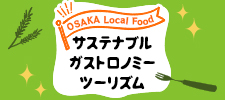
Stroll around Osaka in an antique kimono
If you want to enjoy Japan even more, why not try wearing a kimono? Kimonos, which were worn by women on a daily basis during the Taisho period (1912-1926) and early Showa period (circa 1930-1940s), have become very popular among stylish Japanese women in recent years as antique kimonos. A bit different from the formal, orthodox kimono, the retro-modern antique kimono has bold patterns and pretty colors, making it perfect for everyday activities such as shopping and walking around town. Stroll around Nakazakicho, a town that looks great in such a stylish kimono. As you walk through Osaka's old townscapes and quaint alleyways, you can enjoy the calm Japanese atmosphere. Tip: When eating in a kimono, avoid eating noodles such as udon, soba, and ramen that tend to splatter, and yakiniku that tend to get smelly if possible.
-
START
Osaka Municipal Subway Tanimachi Line "Nakazakicho" Station
-
3minutes WalkKimono Rikka

About a 3-minute walk down the main street from Nakazakicho Station, when you enter the narrow passage next to the beauty salon and open the door, you'll find many kimonos lined up in a narrow space. In addition to selling antique kimonos and accessories in retro and cute colors such as purple, vermilion, and orange, and Japanese-patterned haggis, we also sell denim kimonos that match modern life, and German-made kimonos with pretty embroidery. There are also geta with ribbons as thongs. Be sure to check out this select shop run by the owner who loves kimonos.
You can also rent kimonos for the day here.
Choose a kimono with your favorite pattern, kimono, obi, underwear, tabi, rental accessories and a set including dressing for 9,000 yen + tax per day.Due to busy seasons, it is best to contact us in advance.
Enjoy walking around Osaka in a stylish kimono.Kimono Rikka (ricca)3-2-31 Nakazaki, Kita-ku, Osaka
11:00-19:00 (Reception until 17:30) Closed on Mondays, 2nd, 3rd, and 4th Tuesdays Contact: http://ricca.co.jp/rental-contact/A short walk -
Nakazakicho area

The Nakazakicho area is a unique area where young people run general stores and cafes here and there in the old townscape that survived the war damage. Its landmarks are the small, colorful signboards perched on the eaves of old wooden houses and the stylishly designed entrance. Grandma stands and talks leisurely next to a cat basking in the sun. The idyllic scenery of children playing ball in the alley and the small, unique shops that have been carefully designed go together in a strange way. If you see a store that interests you, don't hesitate to enter.
Handmade town Nakazaki walking mapNakazaki-Nakazaki Nishi, Kita-ku, Osaka City
5minutes on foot -
The Osaka Museum of Housing and Living

When you go up to the 9th floor of a corner building on Tenjinbashisuji 6-chome in Kita, Osaka, you will see a life-sized view of Osaka from the Edo period (first half of the 1830s). Once you step into the town, you'll find bath shops, drug stores, accessory wholesalers, and kimono shops, and as you walk through the alleys, you'll get a glimpse of the lives of the common people in the back row houses. The massive breadwinner, the scent of tatami and wood, and the white plaster walls. The flow of the day is staged with light and sound, sometimes including the sound of thunder, festival music, and the sounds of people speaking at wellside meetings. The space feels like you've wandered into a historical drama, and it's like another world. Also, on the 8th floor, life in modern Osaka is recreated with detailed models and materials. The museum shop carries a wide variety of nostalgic toys and sweets. Perfect as a souvenir.
see spot15 min walk -
Sonezaki Ohatsu Tenjin Dori Shopping Street

Located near Umeda, the center of Osaka, is a lively shopping street lined with numerous restaurants and amusement buildings. Immediately after the end of the war, restaurants began to gather in the precincts of Ohatsu Tenjin, and the area flourished as a dining district with around 30 restaurants. Some of the shops that existed at that time are still in operation today. There are many popular and famous restaurants from the past, such as Yukari, which is famous for its original okonomiyaki, and Hontonpei, which serves the original tonpeiyaki (a type of teppanyaki made with egg and pork belly). Be sure to take a stroll through this lively shopping street, which is busy day and night as a dining destination for businessmen and office ladies working in the Umeda area.
see spot4-minute walk -
Open-air shrine (Ohatsutenjin)

Located at the end of the Sonezaki Ohatsu Tenjin Dori shopping street, this is an old shrine with a history of 1,300 years since its establishment, and is still popular today as the guardian deity of the Sonezaki/Umeda area. It is widely known as ``Ohatsu Tenjin'' by a popular writer at the time, based on the actual suicide incident that took place in the precincts of this shrine in 1703, between Ohatsu, a prostitute, and Tokubei, a servant at a soy sauce shop. From the puppet joruri ``Sonezaki Shinju'' written by Monzaemon Tachikamatsu. This tear-jerking work became so popular that even today, many people visit the shrine to pray for the couple's success in Buddhahood and for their love to be fulfilled. In the temple grounds, where the bronze statues of the two men built using donated funds, stand, you can reflect on a sad love story from over 300 years ago.
see spot - GOAL!
Additional Information
- Taste spot
- Hanatani Yamanaka is recommended for lunch in Nakazaki-cho. The lunch menu, where you can enjoy authentic Japanese cuisine created by a head chef who trained for 30 years at a long-established restaurant, is very reasonably priced, starting at 1,260 yen.
- souvenir
- ``Nijiyura'', a tenugui specialty store in Nakazakicho, is a shop that sells hand-dyed tenugui towels with unique, blurred colors. Tenugui with stylish patterns created by young designers are recommended as they can be used as handkerchiefs or as interior decorations.













